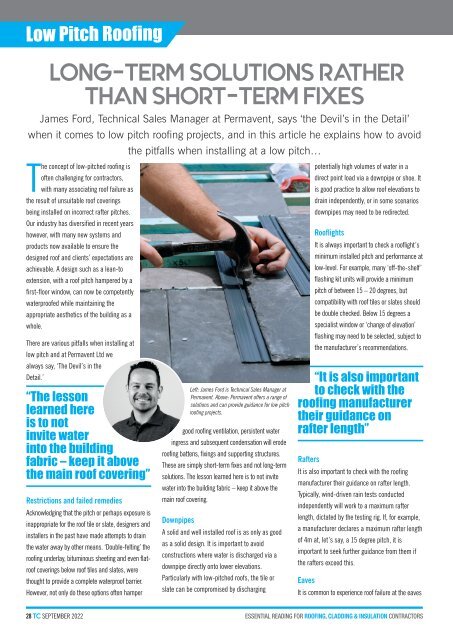September 2022
Create successful ePaper yourself
Turn your PDF publications into a flip-book with our unique Google optimized e-Paper software.
Low Pitch Roofing<br />
LONG-TERM SOLUTIONS RATHER<br />
THAN SHORT-TERM FIXES<br />
James Ford, Technical Sales Manager at Permavent, says ‘the Devil’s in the Detail’<br />
when it comes to low pitch roofing projects, and in this article he explains how to avoid<br />
the pitfalls when installing at a low pitch…<br />
The concept of low-pitched roofing is<br />
often challenging for contractors,<br />
with many associating roof failure as<br />
the result of unsuitable roof coverings<br />
being installed on incorrect rafter pitches.<br />
Our industry has diversified in recent years<br />
however, with many new systems and<br />
products now available to ensure the<br />
designed roof and clients’ expectations are<br />
achievable. A design such as a lean-to<br />
extension, with a roof pitch hampered by a<br />
first-floor window, can now be competently<br />
waterproofed while maintaining the<br />
appropriate aesthetics of the building as a<br />
whole.<br />
There are various pitfalls when installing at<br />
low pitch and at Permavent Ltd we<br />
always say, ‘The Devil’s in the<br />
Detail.’<br />
“The lesson<br />
learned here<br />
is to not<br />
invite water<br />
into the building<br />
fabric – keep it above<br />
the main roof covering”<br />
Restrictions and failed remedies<br />
Acknowledging that the pitch or perhaps exposure is<br />
inappropriate for the roof tile or slate, designers and<br />
installers in the past have made attempts to drain<br />
the water away by other means. ‘Double-felting’ the<br />
roofing underlay, bituminous sheeting and even flatroof<br />
coverings below roof tiles and slates, were<br />
thought to provide a complete waterproof barrier.<br />
However, not only do these options often hamper<br />
Left: James Ford is Technical Sales Manager at<br />
Permavent. Above: Permavent offers a range of<br />
solutions and can provide guidance for low pitch<br />
roofing projects.<br />
good roofing ventilation, persistent water<br />
ingress and subsequent condensation will erode<br />
roofing battens, fixings and supporting structures.<br />
These are simply short-term fixes and not long-term<br />
solutions. The lesson learned here is to not invite<br />
water into the building fabric – keep it above the<br />
main roof covering.<br />
Downpipes<br />
A solid and well installed roof is as only as good<br />
as a solid design. It is important to avoid<br />
constructions where water is discharged via a<br />
downpipe directly onto lower elevations.<br />
Particularly with low-pitched roofs, the tile or<br />
slate can be compromised by discharging<br />
Rafters<br />
potentially high volumes of water in a<br />
direct point load via a downpipe or shoe. It<br />
is good practice to allow roof elevations to<br />
drain independently, or in some scenarios<br />
downpipes may need to be redirected.<br />
Rooflights<br />
It is always important to check a rooflight’s<br />
minimum installed pitch and performance at<br />
low-level. For example, many ‘off-the-shelf’<br />
flashing kit units will provide a minimum<br />
pitch of between 15 – 20 degrees, but<br />
compatibility with roof tiles or slates should<br />
be double checked. Below 15 degrees a<br />
specialist window or ‘change of elevation’<br />
flashing may need to be selected, subject to<br />
the manufacturer’s recommendations.<br />
“It is also important<br />
to check with the<br />
roofing manufacturer<br />
their guidance on<br />
rafter length”<br />
It is also important to check with the roofing<br />
manufacturer their guidance on rafter length.<br />
Typically, wind-driven rain tests conducted<br />
independently will work to a maximum rafter<br />
length, dictated by the testing rig. If, for example,<br />
a manufacturer declares a maximum rafter length<br />
of 4m at, let’s say, a 15 degree pitch, it is<br />
important to seek further guidance from them if<br />
the rafters exceed this.<br />
Eaves<br />
It is common to experience roof failure at the eaves<br />
28 TC SEPTEMBER <strong>2022</strong>

















